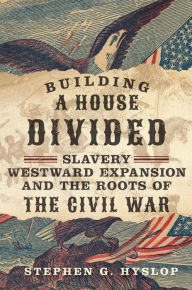Download Pdf Building a House Divided: Slavery,
Building a House Divided: Slavery, Westward Expansion, and the Roots of the Civil War. Stephen G. Hyslop

Building-a-House-Divided.pdf
ISBN: 9780806192734 | 328 pages | 9 Mb

- Building a House Divided: Slavery, Westward Expansion, and the Roots of the Civil War
- Stephen G. Hyslop
- Page: 328
- Format: pdf, ePub, fb2, mobi
- ISBN: 9780806192734
- Publisher: University of Oklahoma Press
Download free ebooks for joomla Building a House Divided: Slavery, Westward Expansion, and the Roots of the Civil War (English literature) 9780806192734 ePub by Stephen G. Hyslop
By the time Abraham Lincoln asserted in 1858 that the nation could not “endure permanently half slave and half free,” the rift that would split the country in civil war was well defined. The origins and evolution of the coming conflict between North and South can in fact be traced back to the early years of the American Republic, as Stephen G. Hyslop demonstrates in Building a House Divided, an exploration of how the incipient fissure between the Union’s initial slave states and free states—or those where slaves were gradually being emancipated—lengthened and deepened as the nation advanced westward. Hyslop focuses on four prominent slaveholding expansionists who were intent on preserving the Union but nonetheless helped build what Lincoln called a house divided: Presidents Thomas Jefferson, Andrew Jackson, and James K. Polk and Senator Stephen A. Douglas of Illinois, who managed a plantation in Mississippi bequeathed by his father-in-law. Hyslop examines what these men did, collectively and individually, to further what Jefferson called an “empire of liberty,” though it kept millions of Black people in bondage. Along with these major figures, in all their conflicts and contradictions, he considers other American expansionists who engaged in and helped extend slavery—among them William Clark, Stephen Austin, and President John Tyler—as well as examples of principled opposition to the extension of slavery by northerners such as John Quincy Adams and southerners like Henry Clay and Thomas Hart Benton, who held slaves but placed preserving the Union above extending slavery across the continent. The long view of the path to the Civil War, as charted through the Jeffersonian and Jacksonian eras in this book, reveals the critical fault in the nation’s foundation, exacerbated by slaveholding expansionists like Jefferson, Jackson, Polk, and Douglas, until the house they built upon it could no longer stand for two opposite ideas at once.
» Imagining the West, territorial expansion, and the politics
In December of 1860, slave states in the deep South began to secede in anticipation of potential legislation to limit slavery. The Civil War began shortly
Chapter 7 Introductory Essay: 1844-1860
Civil War. Texas, the Mexican War, and Slavery's Expansion. In the two decades after it was adopted in 1820, the Missouri Compromise promised that virtually
Westward Expansion - Timeline, Events & Facts
Dec 15, 2009 —
Stephen G. Hyslop: Books
Building a House Divided: Slavery, Westward Expansion, and the Roots of the Civil War Pre-order Price Guarantee. This title has not yet been released.
Browse Books
Browse Books ; Building a House Divided: Slavery, Westward Expansion, and the Roots of the Civil War (Hardcover). By Stephen G. Hyslop ; Lincoln's American Dream:
Links:
Read [pdf]> The FBI War on Tupac Shakur: The State Repression of Black Leaders from the Civil Rights Era to the 1990s by John Potash
DOWNLOAD [PDF] {EPUB} Dry Humping: A Guide to Dating, Relating, and Hooking Up Without the Booze by TAWNY LARA
Online Read Ebook Berserk - A l'encre des ténèbres
PDF [Download] The Shell: Memoirs of a Hidden Observer by Moustafa Khalifa, Paul Starkey
[Descargar pdf] EL ORO DE MUSSOLINI
0コメント